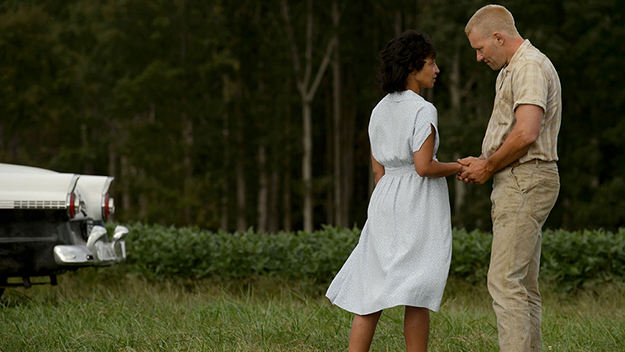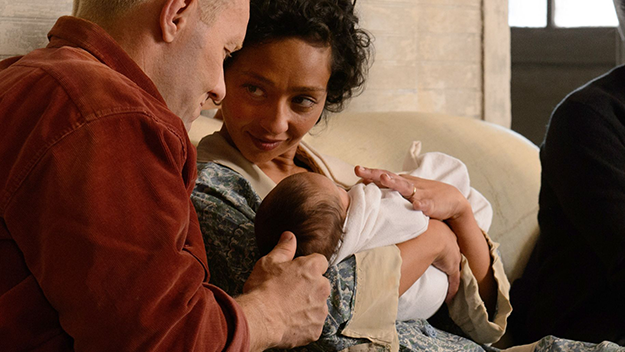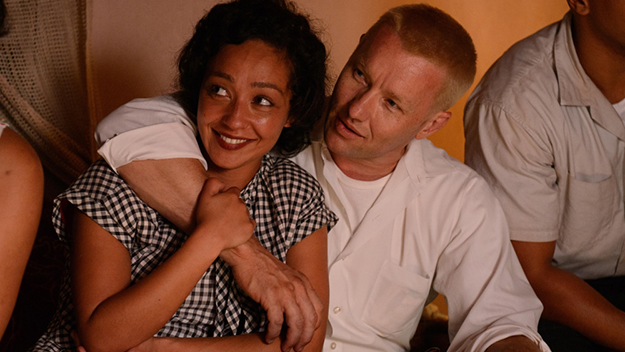Deep Focus: Loving

Jeff Nichols’s tender, earnest new film Loving follows Mildred and Richard Loving (Ruth Negga and Joel Edgerton), an African-American/Native American woman and a white man, from 1958, when they get married (in D.C.) and are tossed into jail in Virginia because of the state’s anti-miscegenation laws, to 1967, when the U.S. Supreme Court considered the case of Loving v. Virginia and declared that the state’s ban on interracial marriage was unconstitutional. Nichols based his script “in part” on Nancy Buirski’s engrossing, big-hearted documentary The Loving Story, which premiered on HBO on Valentine’s Day in 2012, and he strives to maintain fidelity to the salient facts and reverence for the couple’s warmth and devotion, with nary a hint of sensationalism. He gambles that by immersing the audience in the integrated and communal environment of their hometown, Central Point in Caroline County, he’ll be able to convey their shock and terror when the local sheriff (Martin Csokas) and Judge Leon Bazile (David Jensen) throw the full weight of the state’s justice system against them.
The tale contains so much built-in fascination and is told with such sincerity that it’s hard not to get caught up in the Lovings’ plight. After we’ve seen their bedroom invaded at 2 a.m. by lawmen who sneer at the D.C. marriage license posted on the wall and lock them up in separate jail cells, any flashlight or strange car streaking down a road seems a harbinger of doom. The Lovings plead guilty to violating Virginia’s Racial Integrity Act and receive suspended sentences of a year in jail, provided they leave “Caroline County and the state of Virginia at once and do not return together or at the same time to said county and state for a period of twenty-five years.” They move into the Washington D.C. house of one of Mildred’s cousins and try to adjust to city life, as they raise three children. But Mildred longs for her rural home, and her yearning will lead to further jeopardy—and final justice.
Between crises, Loving made me restless. Yet when the final crawl came up, with its poignant statements about the Lovings’ enduring love, I found myself on the verge of tears. Loving is a dogged work, not a great or inspired one, but it gets to you nonetheless.

The movie’s strength is also its weakness: its stop-and-go storytelling and fitful pace aim to mirror the simplicity, confusion, wishful thinking, and occasional shrewdness of its lead characters. The result is at best raw and powerful, at worst pedestrian. Though he was savvy enough to know that he and Mildred would need to be married in Washington, Richard Loving felt that as long they kept to themselves in Central Point, the authorities would leave them alone. Mildred, only 18 when they married (Richard was 23), went along with him. Nichols tries to conjure a dense and enveloping atmosphere to help us understand how the Lovings could feel safe in the integrated small world of Central Point. But it’s difficult to figure out some of the most basic relationships. When Richard passes a pregnant woman on his way into his mother’s house, I thought it was his sister; it took me a while to realize that the woman is a stranger and his mother (Sharon Blackwood) is a midwife. (Richard did have two older sisters, but they didn’t make it into the movie.) More contained characters, like Csokas’s awesomely self-righteous sheriff; Bill Camp’s small-town defense lawyer, who is only sympathetic to a point; and Michael Shannon’s subtly observant Life photographer Grey Villet, end up stealing their part of the show.
If you read through Peter Wallenstein’s Race, Sex, and the Freedom to Marry: Loving v. Virginia, it’s startling to realize that to get a handle on this simultaneously wispy and momentous story Nichols had to simplify its events and cast of characters. In reality, Richard and Mildred were expecting a second child, not their first, on their wedding day, and she was at least five months pregnant when they were first jailed. (They had two boys, then a girl.) In the movie, the Lovings get caught and jailed again because Mildred wants Richard’s mom to deliver her first child. It adds some primal stress, but it also makes you wonder why Richard doesn’t hightail it back to D.C. at the break of dawn. In The Loving Story, Mildred says they had simply gone to Virginia for an Easter visit; she thought they were legally in the clear to make occasional visits. Loving does a shakier job of putting us into the mind-set of a couple who can’t comprehend a law at odds with their daily experience. Nichols does evoke the fun and games of drag races and R&B-flavored parties, but unlike an Altman or a Demme, he rarely lets us feel the agitation pulsing through them. Rifts emerge with a heavy hand. After Richard and his black racing friends vanquish an all-white team, Nichols’s cutaway shot to the sullen losers might as well carry the caption, “Trouble brewing.” (Nichols follows the suggestion, repeated in Wallenstein’s book, that Richard’s envious competitors might have blown the whistle on his marriage.) The conflicting attitudes among African-American kith and kin over Richard voluntarily experiencing the bias and repression of the Jim Crow South surface abruptly over a round of drinks, without any preparation (or follow-through).
Negga gives the performance of the movie, imbuing Mildred with an astute psychological awareness and even some covert slyness. Mildred’s refusal to accept city life for herself or for her children, and her longing for home, are ultimately what catalyze the court case. Negga is astounding at conveying the stubbornness and strength of an essentially gentle nature. But even she gets hemmed in by the writer-director’s haziness. Once Mildred’s cousin’s wife, Laura, welcomes them into their D.C. home, the relatives disappear from the movie. How uncomfortable was it for them and the Lovings to live in close quarters? How does Mildred fill her days in D.C.? Nichols is such a neutral, un-dynamic moviemaker that at a critical turning-point in the action—her boys, Donald and Sidney, are playing in the street, when Donald is hit by a car—the director resorts to a portentous, excruciating buildup, cutting between the children and Richard in his hard-hat under some flimsy scaffolding at a work-site. (It’s about as subtle as a silent-movie ingénue being tied to railroad tracks.) When Laura finally turns up again to suggest that Mildred request assistance from Attorney General Robert Kennedy, she might simply be compassionate. Or, as Wallenstein indicates, she might also be sick of Mildred’s “chronic complaining.”

The story never loses its pull, and the dramatic tension heightens when the ACLU takes up the Lovings’ case and they decide to live in secret deep in the Virginia countryside. Nick Kroll gives an intriguing performance as attorney Bernard Cohen, who combines genuine concern with professional ambition and insecurity. (Wallenstein writes, “Even the couple’s name delighted him, as he foresaw the case taking the name ‘Loving versus Virginia’ when it went to the U.S. Supreme Court, as he guessed it surely would.”) Kroll and Jon Bass as Phil Hirschkop, the civil rights lawyer who also worked on the case pro bono, exude an urban-male avidity that comes as a relief from Edgerton’s instinctive, inarticulate stability—even when the lawyers seem willing to put their clients at risk for the good of the case.
In the documentary The Loving Story, Richard fumbles with words and seems abashed in front of the camera. Edgerton has an extraordinary physical and aural resemblance to the actual Richard, but Nichols edges him into playing a more conventional strong, silent type, who can make his words count when they really matter. Nichols’s production and Edgerton’s performance, which is often self-conscious and forced, reach their peak when Richard tells Cohen to tell the Supreme Court, simply, “I love my wife.” I wish I could say, “I love this movie.”
Michael Sragow is a contributing editor to Film Comment and writes its Deep Focus column. He is a member of the National Society of Film Critics and the Los Angeles Film Critics Association. He also curates “The Moviegoer” at the Library of America website.







